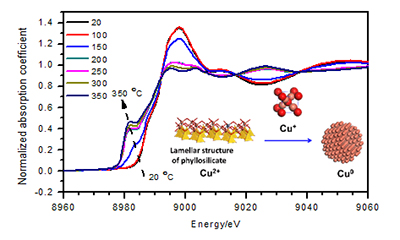| [1] Zong, H. Y.; Tu, Y. B.; Chen, S. P.; Liu, Z. N. Ind. Catal. 2015, 23, 234(in Chinese). (宗弘元, 涂云宝, 陈仕萍, 刘仲能, 工业催化, 2015, 23, 234.)
[2] Guan, X.; Cao, Z. B.; Han, D. Y.; Yang, T. Y.; Gong, J. Y. Contemp. Chem. Ind. 2015, 44, 991(in Chinese). (管鑫, 曹祖宾, 韩冬云, 杨天宇, 宫建远, 当代化工, 2015, 44, 991.)
[3] Zhang, Y. L.; Wang, M.; Cao, P.; Liao, J. Acta Chim. Sinica 2017, 75, 794(in Chinese). (张涌灵, 王敏, 曹鹏, 廖建, 化学学报, 2017, 75, 794.)
[4] Wang, Z. Q.; Xu, Z. N.; Peng, S. Y.; Zhou, Z. F.; Pan, P. B.; Lin, L.; Qin, Y. Y.; Guo, G. C.; Yao, Y. G. Chin. J. Chem. 2017, 35, 759.
[5] Zhu, Y.; Kong, X.; Cao, D.-B.; Cui, J.; Zhu, Y.; Li, Y.-W. ACS Catal. 2014, 4, 3675.
[6] Ma, X.; Chi, H.; Yue, H.; Zhao, Y.; Xu, Y.; Lv, J.; Wang, S.; Gong, J. AIChE J. 2013, 59, 2530.
[7] Kong, X.; Ma, C.; Zhang, J.; Sun, J.; Chen, J.; Liu, K. Appl. Catal. A 2016, 509, 153.
[8] Li, H.; Huang, W. J.; Xiao, C. C.; Cong, H. F.; Gao, X.; Li, X. G. Chem. Ind. Eng. Prog. 2015, 34, 3644(in Chinese). (李洪, 黄伟进, 肖财春, 从海峰, 高鑫, 李鑫钢, 化工进展, 2015, 34, 3644.)
[9] Chen, G.; Shen, W.; Xu, H. L. Acta Chim. Sinica 2002, 60, 1601(in Chinese). (陈庚, 沈伟, 徐华龙, 化学学报, 2002, 60, 1601.)
[10] Yin, A. Y.; Guo, X. Y.; Dai, W. L.; Fan, K. N. Acta Chim. Sinica 2010, 68, 1285(in Chinese). (尹安远, 郭晓洋, 戴维林, 范康年, 化学学报, 2010, 68, 1285.)
[11] van de Scheur, F. T.; Staal, L. H. Appl. Catal. A 1994, 108, 63.
[12] Chen, L.-F.; Guo, P.-J.; Qiao, M.-H.; Yana, S.-R.; Li, H.-X.; Shen, W.; Xu, H.-L.; Fan, K.-N. J. Catal. 2008, 257, 172.
[13] Guo, X.; Yin, A.; Dai, W.-L.; Fan, K. Catal. Lett. 2009, 132, 22.
[14] Zhao, L.; Zhao, Y.; Wang, S.; Yue, H.; Wang, B.; Lv, J.; Ma, X. Ind. Eng. Chem. Res. 2012, 51, 13935.
[15] Van Der Grift, C. J. G.; Elberse, P. A.; Mulder, A.; Geus, J. W. Appl. Catal. 1990, 59, 275.
[16] Toupance, T.; Kermarec, M.; Lambert, J. F.; Louis, C. J. Phys. Chem. B 2002, 106, 2277.
[17] Gong, J.; Yue, H.; Zhao, Y.; Zhao, S.; Zhao, L.; Lv, J.; Wang, S.; Ma, X. J. Am. Chem. Soc. 2012, 134, 13922.
[18] Chen, L. F.; Guo, P. J.; Qiao, M. H.; Yan, S. R.; Li, H. X.; Shen, W.; Xu, H. L.; Fan, K. N. J. Catal. 2008, 257, 172.
[19] Yang, W. L.; Zhao, Y. J.; Wang, S. P.; Ma, X. B. Chem. Ind. Eng. 2016, 33, 1(in Chinese). (杨文龙, 赵玉军, 王胜平, 马新宾, 化学工业与工程, 2016, 33, 1.)
[20] Grandjean, D.; Pelipenko, V.; Batyrev, E. D.; van den Heuvel, J. C.; Khassin, A. A.; Yurieva, T. M.; Weckhuysen, B. M. J. Phys. Chem. C 2011, 115, 20175.
[21] Catillon-Mucherie, S.; Ammari, F.; Krafft, J. M.; Lauron-Pernot, H.; Touroude, R.; Louis, C. J. Phys. Chem. C 2007, 111, 11619.
[22] Bair, R. A.; Goddard Ⅲ, W. A. Phys. Rev. B 1980, 22, 2767.
[23] DuBois, J. L.; Mukherjee, P.; Stack, T.; Hedman, B.; Solomon, E. I.; Hodgson, K. O. J. Am. Chem. Soc. 2000, 122, 5775.
[24] Kau, L. S.; Spira-Solomon, D. J.; Penner-Hahn, J. E.; Hodgson, K. O.; Solomon, E. I. J. Am. Chem. Soc. 1987, 109, 6433.
[25] Ravel, B.; Newville, M. J. Synchrotron Radiat. 2005, 12, 537.
[26] Frenkel, A. I.; Hills, C. W.; Nuzzo, R. G. J. Phys. Chem. B 2001, 105, 12689.
[27] Nashner, M. S.; Frenkel, A. I.; Adler, D. L.; Shapley, J. R.; Nuzzo, R. G. J. Am. Chem. Soc. 1997, 119, 7760.
[28] Gaur, A.; Shrivastava, B. D.; Joshi, S. K. J. Phys.:Conf. Ser. 2009, 190, 12084. |
